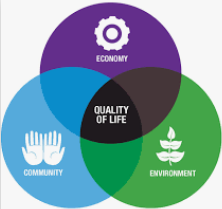President Biden’s infrastructure plan comes with
a hefty price tag -- about $2 trillion over
eight years. Biden calls it a “once
in a lifetime investment in America.” The plan requires new tax revenue. When
he rolled it out, the 27-page fact sheet the White House presented listed not
just rebuilding roads, bridges, schools, upgrading housing, installing electric
charging stations, developing mass transit, and providing redress for usually non-white
neighborhoods divided by highways, it also included detailed tax proposals.
Biden suggests paying primarily with higher corporate taxes.
Battle lines formed quickly. Most Congressional Republicans voiced
opposition, offering the usual argument that increasing taxes kills jobs. Some
Democrats, like West Virginia Senator Joe Manchin, support
smaller tax increases than Biden
wants. So, where does that put the president?
Bumping Up Corporate Taxes
So far, Biden has proposed only corporate tax
changes, something to which most Americans
don’t object. Many didn’t get much
benefit from the 2017 Trump tax cuts which favored corporations and the wealthy. Rolling
them back seems popular. One survey showed support for the infrastructure plan
increased when pollsters told respondents increasing corporate taxes was part
of the plan.
Trump’s cuts reduced the corporate tax rate from
35% to 21%. Few corporations, especially those with international operations,
pay 21%. Loopholes and incentive
provisions allow many companies to whittle
what they actually pay to about
eight
per cent. According to the White House, a “recent independent study found
that 91 Fortune 500 companies paid $0 in federal corporate taxes in 2018.” Biden would change that by, among other things:
*Setting the corporate rate at 28%;
*strengthening the Global Minimum Tax for U.S. Multinational Corporations, stopping American companies from claiming tax haven
countries as their residence, though they have management and operations in the
U.S., a process called “inversion;”
*eliminating intellectual property loopholes that
encourage U.S. companies to locate jobs abroad, a problem the Trump tax bill made
worse by giving tax breaks for shifting assets offshore; and
*enacting a minimum tax on “book income,” profits
large companies report to shareholders, while avoiding reporting those profits
for tax purposes.
The Poor and the Middle Class
Biden apparently does not plan on taxing middle
class and poor taxpayers. The poor
have been saddled with a
federal minimum wage of $7.25 per hour since 2009, a major factor in America’s income inequality.
Since the 1980s the gap between the rich and everyone else has expanded
significantly. As Thomas Piketty reported in Capital and
Ideology, between 1960 and 1980, the bottom 50% of earners claimed 20% of
national income. Between 1980 and 2015, however, the bottom 50% dropped from
20% to 12%. Meantime, the top 10% went
from a little more than 10% of income earned to more than 20%. The public
intuitively understands this, so Biden’s choice not to tax lower income groups
to pay for infrastructure should remain popular.
Public opinion, however, hasn’t translated into GOP support in
Congress. Biden keeps talking with Republicans in the hope of peeling off a few
of their votes. He still thinks the country needs a bipartisan approach
to problems like infrastructure and the funding needed for paying for it. He
says he would welcome input from Republicans on specific proposals. If one of
them has a better idea, he’d like to hear it.
The GOP response has included tepid support
for a much smaller program. Republicans
object to making climate change measures and such things as home care part of
the package, saying that’s not really infrastructure. They’d focus only on
roads, bridges, and other “traditional” infrastructure items. They contend
paring the proposal down, maybe to $600-900 billion, would reduce or eliminate
the need for most, if not all, the tax increases. That’s a dubious proposition
but, so far, it’s all they’re suggesting.
Republicans likely will accuse Biden of fighting
a class war on tax
issues. We think he should argue it’s past time someone fought for poor and
middle class taxpayers (those in the lower 50%) and that corporate America
should pay its fair share. Many Americans believe they elected a president who
would champion the poor and the middle class. The infrastructure plan offers
Biden a good opportunity for proving he’s that president.
2009 All Over?
To date, Biden’s team has resisted the Republican
track, apparently having learned a lesson from the Obama-Biden experience
in
2009. That new administration kept making concessions on the size of the
recession rescue package, hoping that would garner Republican support. Cut this or don’t do that, they said, and we
might support you. ‘Might’ was the key word. No concessions satisfied Republicans and the plan passed with only
Democratic votes. Some warned the package
was too small and
wouldn’t extricate the economy from the ditch it found itself in. Many economists blame
the slow growth that followed on the failure of the administration to “Go
Big.” Biden’s people say they won’t make
that mistake this time.
Americans, of course, generally don’t like tax
increases. Will the current polling showing support for the infrastructure plan
and the tax increases hold, especially after the fear campaign the GOP will
likely run when the
real debate begins?
Who knows? We hope Biden, while continuing
his dedication to bipartisanship as a governing principle, will remember the
lessons of 2009. This country faces
important issues at a perilous moment. Timidity does not seem in order.

















































